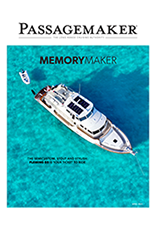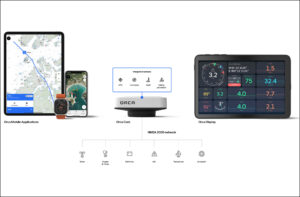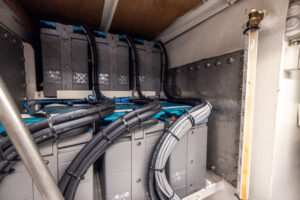
I would have bet on Garmin to be the first of the Big Four marine electronics manufacturers to introduce forward-looking sonar for cruisers. In 2012, Garmin acquired Interphase Technologies, a maker of stand-alone forward-looking sonars on the verge of a breakthrough.
Then came the Miami Boat Show in February. And it was not Garmin, but Simrad that announced ForwardScan, a transducer that sends “a clear picture of what’s ahead” to multifunction displays from the Navico family of companies, which also includes Lowrance and B&G.
To be fair, Furuno has long sold an immensely powerful rotating echo sounder capable of looking far forward (and all around). Furuno’s current Searchlight Sonar line began in 2000 with the release of the CH250 with a transducer that lowers into the water from a housing inside the vessel. Depending on the model, a Searchlight Sonar costs from $12,000 to more than $20,000. The customers for Searchlight are West Coast sportsfishermen competing to win million-dollar tournaments.
Another clever device, 360 Imaging from Humminbird uses the same concept on a more compact and affordable level. The customer base for the 360 are fishermen who don’t mind that the transducer lowers into the water using a transom-mounted assembly. That system isn’t appropriate for a cruising boat, and there is currently no other way to install it, though Humminbird may be working on one.
The Furuno and Humminbird systems cannot be deployed if the boat is going more than 10 knots or so, limiting their navigational usefulness in “fast trawlers.”
Without moving parts, the ForwardScan transducer is more akin to a conventional sounder that has been tipped on its side. Its effective range is about eight times the actual depth, up to about 160 feet ahead of the boat. It includes a built-in shallow depth alarm with parameters set by the user. In deep water, this is great for detecting rocks and pinnacles. Of course, if you are operating in shallow waters such as the Bahamas or portions of the Chesapeake the eight-to-one ratio begins to work against you.
For example, in 12 feet of depth ForwardScan would effectively see 96 feet ahead. A trawler going 6 knots covers 96 feet in less than 10 seconds—not much time to make a decision and act, but better than no warning. But even in shoal water the device might prove useful. I can think of several reef passes in the Bahamas where ForwardScan might have reduced the pucker factor.
Let’s say you know the general vicinity of the pass, but the light is bad for eyeballing the water, and seas are too calm to cause breakers (visually the pass is likely to show as a gap of comparatively calm water between breakers). Let’s say you know the pass has a minimum depth of around 10 feet, so set your alarm for 8. Take your best guess and head for the spot at a crawl, ready to back down and turn away.
Even better this forward scanner works with another Simrad echo technology called Structure Scan, which looks 160 feet out from the sides of the boat. You could run parallel to the reef, detect the pass, mark it with a waypoint and come back at it as described in the previous paragraph.
I hope to test this theory. It would be interesting, too, to determine how effective ForwardScan will be in container detection since the beam is angled slightly downward from the surface of the water. The fact that thousands of containers fall off cargo ships each year is worrisome to passagemakers. Containers tend to float awash; that is, without any of their structure clearly visible on the surface, especially at night.
One of the clear benefits of a Big Four forward-looking sonar is the fact that it would be part of an integrated system, with more options to leverage sonar data compared to a stand-alone unit from Garmin-Interphase (so far) or its British competitor EchoPilot. For example, ForwardScan images can be viewed on smartphones and viewed and operated from tablets on vessels equipped with the Simrad GoFree Wi-Fi module. If ForwardScan works as advertised, Navico will benefit in the marketplace from having two unique technologies useful to cruisers, the other being Broadband Radar.
The retail price of a ForwardScan transducer is $699. Visit www.simrad-yachting.com.







